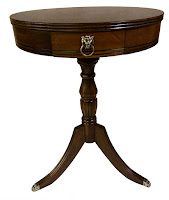 |
Caned Chair After
w/repaired seat |
 |
Caned Chair Before
w/broken seat |
Caned chairs are a nice addition to a home because they add a customized, textured touch with their hand caned seats. Unfortunately, they are easily damaged when someone tries to stand on them or can be damaged with a knee placed strategically in the center of the seat itself, which results in broken cane.
These two caned chairs were strand caned, therefore each seat is hand woven with individual strands of very long caning, a natural product grown in warm climates, such as southeast Asia, including Malaysia, China, Singapore and the Philippines. History shows that caning is an ancient craft dating back to Egyptian times.
This natural cane originates in the Rattan family, which is a wild creeping vine that grows freely in these countries. The outer bark is stripped away, leaving a shiny exterior bark. This is used for chair caning. The strands used in this style of caning can be up to 12 feet long. Each strand is then carefully woven through the holes on the outer edge of the chair's seat (and back) and follows a specific pattern to create the finished caned seat. The weaving process is time-consuming and can take 2-4 days to complete one chair.
The first chair in this pair has a larger seat area than the second chair, so it took a bit longer to complete. Caned chairs can be painted or stained, but I don't recommend it because it dries out the natural caning, which ultimately makes it weaker and more apt to become damaged.
 |
Chair After
w/repaired seat |
 |
Chair Before
w/broken seat |
Caning can also be done in a "press-in" manner, which differs because the caning is purchased as a pre-fabricated, woven section and pressed into a channel cut into the seat with a spline that secures the caning tightly into the opening. It is important to pre-soak the caning for at least an hour before it is pliable to press into the opening of the seat.
No matter what form of caning chair you choose to furnish your home with, it is going to create a warm, inviting touch showing the natural fibers of the caning as well as the craftsmanship of the person who created it.


















